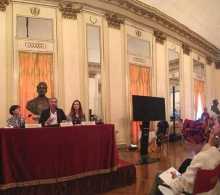
The fashion industry has long been a leading contributor to climate change, accounting for roughly 10% of global carbon emissions and wasting prodigious amounts of water (Did you know the production of a single pair of blue jeans can consume 10,000 liters?). Factor in the pollution of local ecosystems due to dyes and toxic waste alongside inhumane treatment of workers and it becomes very clear that “fast fashion” has serious social and environmental impacts that need to be addressed.
The Fashion4Climate campaign works with partners to emotionally engage consumers and encourage sustainable innovation and climate leadership in the industry. Fashion and style are uniquely personal; our clothes act as ever-present reminders of our identities and values and can be harnessed to connect with and activate audiences, transforming them into conscious consumers. By providing opportunities for pioneering young designers at Milan Design Week, highlighting the social and environmental impacts of the fashion industry through virtual reality, and spreading the message of sustainable fashion with Climate Action Bracelets by the renowned Cruciani, Connect4Climate has unequivocally supported the fashion industry’s transition from harmful practices to helpful ones. Fashion is poised not merely to right its past environmental wrongs, but to become a leading driver of global change and the implementation of the Sustainable Development Goals.
[video:https://vimeo.com/375147484]
Connect4Climate was among the ten organizations that in 2019 jointly launched the UN Alliance for Sustainable Fashion, a strategic initiative aimed at harnessing the reach and creativity of fashion to help achieve the UN’s Sustainable Development Goals and finding avenues for meaningful action on both the labor side and the consumer side of the industry. C4C is also a proud supporter of the UN’s Fashion Industry Charter for Climate Action (just renewed in 2021), whose mission “to drive the fashion industry to net-zero greenhouse gas emissions no later than 2050 in line with keeping global warming below 1.5 degrees” calls for action across domains including manufacturing, logistics, and policy engagement.
In recent years, C4C has helped stage world tours of the “X-Ray Fashion” virtual reality experience, an interactive virtual reality narrative by the Danish studio MANND co-produced by Connect4Climate and Paul Allen’s Vulcan Productions. The winning concept from C4C’s 2017 Uniting Climate VR Pitch Competition, “X-Ray Fashion” gives users an unflinching first-hand look at the life cycle of the garments they wear—beginning in the oppressive workspace of a garment factory and ending amid huge heaps of landfill waste—and encourages them to take informed action in response. Each of us has the power to educate ourselves on what brands are putting people and planet before profit, spend accordingly, and share our knowledge with others. We can support the sustainable fashion movement by reusing what we wear, upcycling old garments, reducing our consumption of new clothes, and calling on our favorite fashion brands to commit to ambitious climate targets.
Are you doing exciting work in the fashion space? Whether you’re a sustainable designer or simply an engaged consumer spreading the word on how to make your wardrobe last, we’d love to hear about it!







